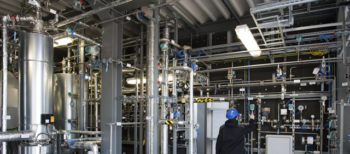Innovation in all its forms in spotlight at first Energy Innovation Forum at IEA Ministerial
 The global energy technology landscape has been transformed over the 50 years since the IEA’s founding in 1974 – and the expansion of key clean energy technologies is now unstoppable. But while a host of new technologies is now readily available, clean energy innovation is more necessary than ever before – and it needs to accelerate.
The global energy technology landscape has been transformed over the 50 years since the IEA’s founding in 1974 – and the expansion of key clean energy technologies is now unstoppable. But while a host of new technologies is now readily available, clean energy innovation is more necessary than ever before – and it needs to accelerate.
To address this challenge, the IEA convened some 250 entrepreneurs, business leaders, investors and policy makers from around 45 countries on 13 February 2024 at its Energy Innovation Forum, which kicked off the 2024 IEA Ministerial Meeting in Paris and marked the Agency’s 50th Anniversary.
 Dina Bacovsky, Chair of IEA Bioenergy, was one of the delegates. “This was an exceptional opportunity to exchange with the broader IEA family, a diverse group of actors, united by the wish to accelerate the clean energy transition. Bioenergy is one of the technologies needed to keep international climate targets in reach, and we urgently need to more widely deploy mature technologies and support the development of technologies that still need to be demonstrated at scale. Running a demonstration facility allows you to gather data, learn how your technology fits into the system and train your personnel. Failures will be part of the process, but we must understand that failures are not fatalities but opportunities to learn. IEA Bioenergy is committed to provide science-based information to support the technology innovation required to transform our energy system.”
Dina Bacovsky, Chair of IEA Bioenergy, was one of the delegates. “This was an exceptional opportunity to exchange with the broader IEA family, a diverse group of actors, united by the wish to accelerate the clean energy transition. Bioenergy is one of the technologies needed to keep international climate targets in reach, and we urgently need to more widely deploy mature technologies and support the development of technologies that still need to be demonstrated at scale. Running a demonstration facility allows you to gather data, learn how your technology fits into the system and train your personnel. Failures will be part of the process, but we must understand that failures are not fatalities but opportunities to learn. IEA Bioenergy is committed to provide science-based information to support the technology innovation required to transform our energy system.”
“In the IEA’s Net Zero by 2050 Scenario, 35% of emissions reductions come from low-emissions technologies that are not yet at market scale. By 2030, a suite of major demonstration projects will need to have been financed, built and operated, to become a bankable, first-choice investment around the world,” said IEA Executive Director Fatih Birol. “There is a need for every government around the world to sit in the driving seat of innovation, providing leadership, strategy and also the necessary framework for the private sector and other investors and innovators to be incentivised.”
Across a series of plenary sessions and breakout workshops, delegates emphasised how the past 50 years of technology development have provided invaluable lessons about the crucial role of government in fostering innovation and supporting new technologies through to commercialisation.
Governments can create enabling environments that can establish new markets, encourage healthy competition, decrease investment risks and spur both incremental and radical innovation. Participants recognised that governments play an important role in funding foundational R&D and education in the public interest by providing dedicated support for first-of-a-kind projects and facilitating cooperation between researchers and industry.
Today, energy innovation policy is evolving rapidly, with many good examples around the world of creative policy measures that directly support entrepreneurs in reaching commercialisation faster or support manufacturing and industrialisation, with early-stage debt, for example. However, participants highlighted some priority areas in the innovation ecosystem that policy needs to address, including further work on standards and bank guarantees, and the importance of fostering a social license for new technologies.
Selection of technologies that change society’s relationship with energy

Courtesy of Getty images.
1. Fischer-Tropsch process
Invented in the 1920s as a means of producing liquid fuel from gasified coal, the Fischer-Tropsch process is back in vogue as an option to make liquid fuels from low-emissions sources, such as bioenergy or low-emissions hydrogen and carbon dioxide. The challenge is not to prove the technology works, but to show it can be integrated competitively with clean energy resources. The IEA’s Net Zero Emissions by 2050 Scenario sees demand for 3 million barrels per day of these fuels in 2050.

Courtesy of Getty images.
2. Anaerobic digestion for biogas
Biodigesters convert organic waste matter such as manure or food waste into a combustible gas that can serve as a substitute for fossil fuels, while also avoiding methane emissions associated with untreated waste. Because the removal of the carbon dioxide (CO₂) from raw biogas yields methane, the main component of natural gas, expanding biodigestion is key to the European Union’s plan to reduce demand for Russian natural gas. The EU targets 35 billion cubic metres of biomethane production in 2030. Biogas “upgrading” to biomethane is also one of the cheapest sources of non-fossil CO₂, which is in high demand in the IEA’s Net Zero Emissions by 2050 Scenario as an input to the production of low-emissions synthetic fuels.
More info can be found here:
- Recordings from the Forum’s sessions (except for the breakout sessions) are available on the event page
- The IEA Ministerial communiqué, particularly noting paragraphs 16 and 17 recognising the TCP and reflecting IEA’s strengthened mandate on international energy technology cooperation
- A web article on iea.org summarising the Forum’s outcomes, including a video broadcast during the opening session that features CERT and TCPs
- The virtual photo exhibition of 50 Technologies that Changed Energy
- Photos from the Forum


